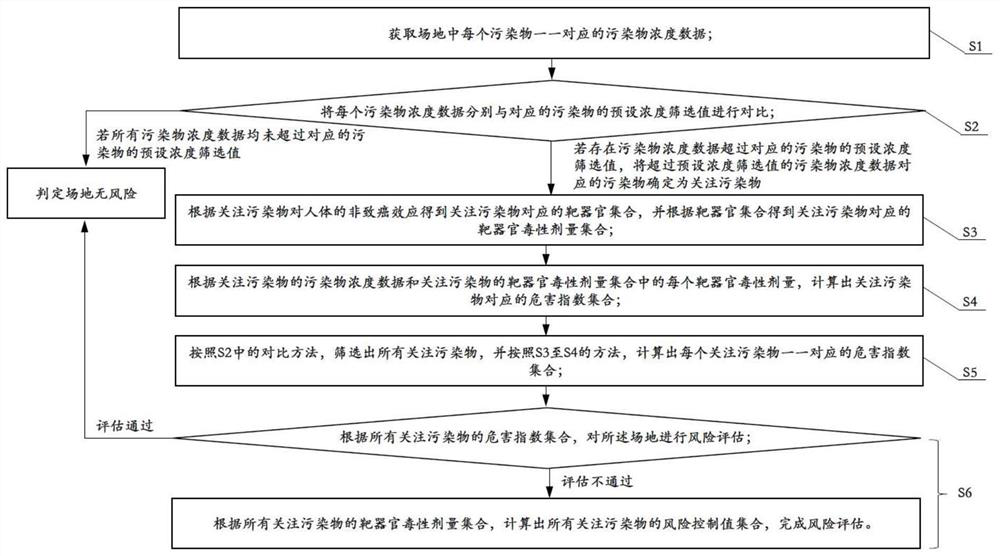Risk assessment method and system based on target organ classification, and storage medium
A risk assessment, target organ technology, applied in urinary function assessment, nervous system assessment, instruments, etc., can solve the problem of classification of pollutants that do not solve the non-carcinogenic effect, and the non-carcinogenic risk level of soil and soil and the main target organs can not be obtained. Groundwater risk control value and other issues, to achieve the effect of improving the efficiency of risk assessment and reducing the cost of restoration
- Summary
- Abstract
- Description
- Claims
- Application Information
AI Technical Summary
Problems solved by technology
Method used
Image
Examples
Embodiment 1
[0030] Embodiment one, as figure 1 As shown, a risk assessment method based on target organ classification includes the following steps:
[0031] S1: Obtain the one-to-one corresponding pollutant concentration data of each pollutant in the site;
[0032] S2: Compare each pollutant concentration data with the preset concentration screening value of the corresponding pollutant. The pollutants corresponding to the pollutant concentration data exceeding the preset concentration screening value are determined as pollutants of concern, and S3 is executed; if all the pollutant concentration data do not exceed the corresponding preset concentration screening value, it is determined that the site is risk-free;
[0033] S3: Obtain the target organ set corresponding to the concerned pollutant according to the non-carcinogenic effect of the concerned pollutant on the human body, and obtain the target organ toxicity dose set corresponding to the concerned pollutant according to the target...
Embodiment 2
[0192] Embodiment two, such as Figure 5 As shown, a risk assessment system based on target organ classification, including a data acquisition module, an initial assessment module, a risk characterization module, a reassessment module and a control value calculation module;
[0193] The data acquisition module is used to acquire the pollutant concentration data corresponding to each pollutant in the site;
[0194] The initial evaluation module is used to compare each pollutant concentration data with the preset concentration screening value of the corresponding pollutant, if there is any pollutant concentration data in all the pollutant concentration data that exceeds the preset value of the corresponding pollutant. Concentration screening value, the pollutant corresponding to the pollutant concentration data exceeding the preset concentration screening value is determined as the pollutant of concern; if all pollutant concentration data do not exceed the corresponding preset c...
Embodiment 3
[0199] Embodiment 3. Based on Embodiment 1 and Embodiment 2, this embodiment also discloses a risk assessment system based on target organ classification, including a processor, a memory, and a system stored in the memory and operable on the processor. A computer program on the computer program, when the computer program runs, it realizes as figure 1 The specific steps from S1 to S6 are shown.
[0200] The risk assessment of the present invention is realized through the computer program stored in the memory and run on the processor. Based on the target organ classification, it not only evaluates the non-carcinogenic risk level of the concerned pollutants to the human body through different exposure routes, but also Focusing on the harmful effects of pollutants specific to target organs, it can reflect in more detail the impact of various pollutants on human health in polluted sites; at the same time, based on the toxic dose of target organs, the set of risk control values is...
PUM
 Login to View More
Login to View More Abstract
Description
Claims
Application Information
 Login to View More
Login to View More - R&D Engineer
- R&D Manager
- IP Professional
- Industry Leading Data Capabilities
- Powerful AI technology
- Patent DNA Extraction
Browse by: Latest US Patents, China's latest patents, Technical Efficacy Thesaurus, Application Domain, Technology Topic, Popular Technical Reports.
© 2024 PatSnap. All rights reserved.Legal|Privacy policy|Modern Slavery Act Transparency Statement|Sitemap|About US| Contact US: help@patsnap.com










